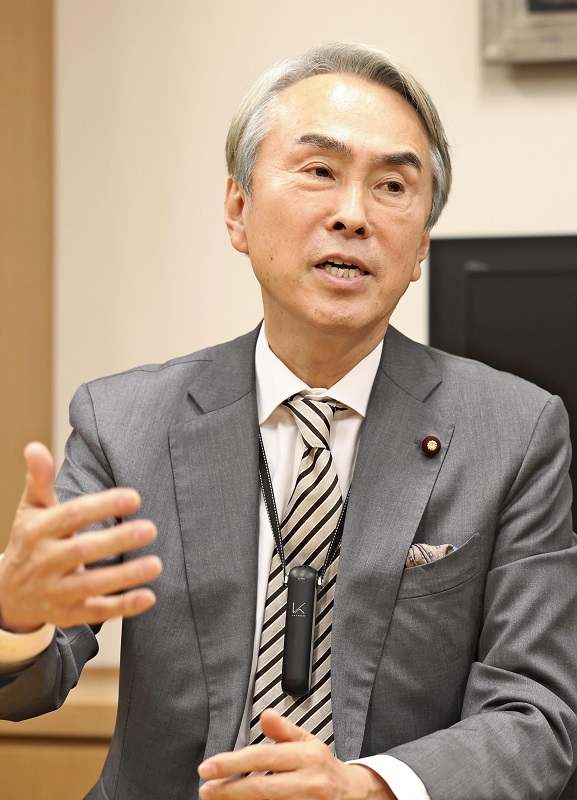11:25 JST, March 16, 2021
March 11 marked the 10th anniversary of the Great East Japan Earthquake in 2011. The Yomiuri Shimbun spoke with Nobuteru Ishihara, who served as secretary general of the Liberal Democratic Party, and asked him to review the situation at the time to pass on lessons for the future. The following is excerpted from the interview.
Ready to help
At the time of the Great East Japan Earthquake in 2011, I was busy working to ascertain the extent of the situation in disaster-hit areas in my capacity as secretary general of the Liberal Democratic Party, which was the largest opposition party. On March 13, two days after the disaster, (then) LPD President Sadakazu Tanigaki and I visited the Prime Minister’s Office, and told (then) Prime Minister Naoto Kan that our party intended to offer our full cooperation.
We leveraged our diverse network of trade groups and corporations, and arranged for the delivery of food, clothes and other supplies to disaster-hit areas. Through these and other initiatives, the LDP did everything it could to provide aid to the afflicted areas.
However, I felt dissatisfied with how the administration at the time responded to the disaster. The then prime minister’s in-person visit to Tokyo Electric Power Co.’s Fukushima No. 1 nuclear power plant added to confusion at the site. Moreover, the Democratic Party of Japan failed to keep even its own house in order, as evinced by internal moves to oust Kan.
In June 2011, the no-confidence motion which we submitted against the Cabinet was ultimately voted down. But I still believe submitting the motion was meaningful, in the sense that it conveyed our message as an opposition party: “Things cannot continue as they are now.”
Stigma suppresses supply
Over the intervening decade, I think much progress has been made in terms of post-disaster reconstruction, including the headway made on relocation to higher land along the coast of Iwate and Miyagi prefectures, which were devastated by the tsunami.
But in Fukushima Prefecture, where the nuclear accident occurred, defamatory rumors continue to stigmatize food products from Fukushima.
Despite enacting stringent standards for radiation in food (see below), which at 100 becquerels per kilogram are stricter than before the disaster, the amount of produce that reaches the market has yet to recover to former levels.
The situation goes beyond mere misinformation, and can only be described as prejudice.
Fukushima Prefecture is also home to a great many scenic mountain villages, where one can still find the original, natural landscapes of Japan. In such areas, the wild vegetable and mushroom harvest had long provided an extra source of income for local farmers, but such produce has ceased to sell due to the slanderous stigma. As a result, people have ceased to enter these rural areas, letting the lands fall to waste.
In order to quell this prejudice, I would like to firmly sound the message that food produced in Fukushima is safe to eat, based on science.
That said, the public’s awareness of disaster prevention has changed significantly over the past 10 years. Locales have been conducting preparatory drills in anticipation of the next big earthquakes and tsunami which will inevitably occur in the future. I have also heard that the number of people taking out earthquake insurance policies is on the rise.
However, I worry that the public’s interest in the Great East Japan Earthquake itself has been waning. The immense reality is that more than 20,000 individuals died or went missing during the disaster.
As we pass each milestone, we must look back and remember what transpired, turning such junctures into opportunities for reconsidering the steps to be taken as we move forward.
Regulating radiation in food
In April 2012, the government set new standards for the permissible levels of radioactive cesium in food following the Great East Japan Earthquake. The upper limits were set at 100 becquerels per kilogram for general foods, 50 becquerels per kilogram for baby food and milk, and 10 becquerels per kilogram for drinking water.

Nobuteru Ishihara / Former LDP secretary general
Served as the environment minister in the second Abe Cabinet and oversaw decontamination work in Fukushima Prefecture. Chairman of the LDP’s Ishihara faction, he has been elected to the House of Representatives 10 times. He is 63.
"Politics" POPULAR ARTICLE
-

Japan to Support Central Asian Logistics Route That Bypasses Russia, Plan to Be Part of Upcoming Summit in Tokyo
-

Japan to Tighten Screening of Foreigners’ Residential Status by Providing Information of Nonpayment of Taxes
-

Chinese, Russian Bombers Flew Unusual Path by Heading Toward Tokyo; Move Likely Meant to Intimidate Japan
-

Japan Plans National Database to Track Foreign Ownership of Real Estate, Land as It Weighs New Rules
-

Up to 199,000 Deaths Estimated From Mega-Tsunami; Most Recent Occurrence Took Place in 17th Century
JN ACCESS RANKING
-

Tokyo Economic Security Forum to Hold Inaugural Meeting Amid Tense Global Environment
-

Keidanren Chairman Yoshinobu Tsutsui Visits Kashiwazaki-Kariwa Nuclear Power Plant; Inspects New Emergency Safety System
-

Imports of Rare Earths from China Facing Delays, May Be Caused by Deterioration of Japan-China Relations
-

University of Tokyo Professor Discusses Japanese Economic Security in Interview Ahead of Forum
-

Japan Pulls out of Vietnam Nuclear Project, Complicating Hanoi’s Power Plans



-250x167.jpg)






















